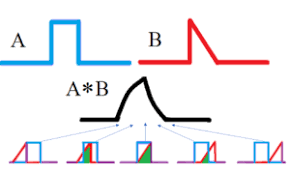Définition
Définition :
Si \(f,g\in\mathscr P\), on définit la convolution de \(f\) et \(g\) : $${{(f*g)(\theta)}}={{\int_\Bbb Tf(t)g(\theta-t)\,dt}}$$

Propriétés
Premier théorème de la convolution
Premier théorème de convolution :
- \(f,g\in\mathscr P\)
- \(h:=fg\)
$$\Huge\implies$$
- \(h\in\mathscr P\)
- $$h(\theta)=\sum_k\underbrace{\left(\sum_nF_nG_{k-n}\right)}_{H_k=(F*G)_k}e^{ik\theta}$$
- autrement dit, $$\widehat{fg}=\hat f*\hat g$$ (premier théorème de convolution)
- on appelle \(H_k\) la convolution discrète des séquences \(F_n\) et \(G_n\)
END
Deuxième théorème de la convolution
Deuxième théorème de la convolution :
- \(f,g\in\mathscr P\)
- \(h:f*g\)
$$\Huge\iff$$
- la fonction \(h\) est bien définie et \(h\in\mathscr P\)
- \(H_n=2\pi F_nG_n\)
Existence et majoration
Proposition :
Soit \(f,g\) des fonctions telles que \(f,g\in L^1({\Bbb R}^d)\)
Alors \(f*g\in L^1({\Bbb R}^d)\) et $$\lVert f*g\rVert_1\leqslant\lVert f\rVert_1\lVert g\rVert_1$$
Proposition :
Soit \(f,g\) des fonctions telles que \(f\in L^1\) et \(g\in L^2({\Bbb R}^d)\)
Alors \(f*g\in L^2({\Bbb R}^d)\) et $$\lVert f*g\rVert_2\leqslant\lVert f\rVert_1\lVert g\rVert_2$$
Proposition :
Soit \(f,g\) des fonctions telles que \(f,g\in L^2({\Bbb R}^d)\)
Alors \(f*g\in L^\infty({\Bbb R}^d)\) et $$\lVert f*g\rVert_\infty\leqslant\lVert f\rVert_\infty\lVert g\rVert_\infty$$ de plus, \(f*g(x)\underset{x\to\pm\infty}\longrightarrow0\)
Commutativité
$${{f*g}}=g*f$$
Associativité
$$f*(g*h)={{(f*g)*h}}$$
Linéarité
$$f*(\lambda g+\mu h)={{\lambda(f*g)+\mu(f*h)}}$$
Commutativité avec les shifts
$$\tau_a(f*g)={{(\tau_af)*g=f*(\tau_ag)}}$$
(
Shift - Translation d'une fonction)
Universalité
Théorème fondamental du traitement du signal
Support
Proposition :
Soient \(f,g\) deux fonctions telles que \(f*g\) est définie presque partout
Alors $${{\operatorname{supp}(f*g)\subseteq\overline{\operatorname{supp}(f)+\operatorname{supp}(g)}}}(f*g)}}$$
(
Support,
Adhérence)
Dérivées
Proposition :
Soit \(f,g\) deux fonctions telles que \(f\in L^1\) et \(g\in\mathcal C^k\) bornée
Alors \(f*g\in\) \(\mathcal C^k\) et on a : $${{(f*g^{(k)})}}={{f*(g^{(k)})}}$$
Approximation de l'identité
Proposition :
Il n'existe pas de fonction \(e\) telle que \(e*f=f\)
Proposition :
Soit \(k\) \(\in L^1({\Bbb R}^d)\) telle que \(\int k=1\) et \(k\overset{pp}\geqslant0\)
Pour une certaine fonction \(h\) \(\gt 0\), on définit les approximations de l'identité (pour la convolution) : $${{k_h(x)}}={{\frac1{h^d}k\left(\frac xh\right)}}$$
Elle est telle que si \(f\) est uniformément continue et bornée sur \({\Bbb R}^d\), alors \(f*k_h\) converge vers \(f\) uniformément
